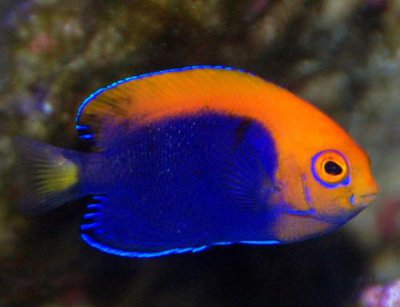African Flameback Angelfish
Category: Angelfish

Facts about African Flameback Angelfish, "Scientific name for African Flameback Angelfish is Centropyge acanthops". The African Flameback Angelfish is a type of dwarf angel fish. That comes from Indian and Pacific Oceans. It is also called the jumping bean angelfish, orange back angel fish and African pygmy angelfish. It looks like the Brazilian flameback angelfish, species name Centropyge aurantonotus, but the African species has a light yellow or orange caudal fin. The Brazilian Flameback Angelfish is also called the fireball angelfish.
The African Flameback Angelfish, a member of the Pomacanthidae family, is so named for the bright orange stripe from its face to its tail while its sides are dark blue or black. They are only three inches long (7.6 cm) at maturity, so they can be kept in tanks as small as 24 gallons (90 liters) of capacity. Fifty gallons (190 liters) is better. The bottom should be covered with rock and sand if not live or fake corral.
The African Flameback Angelfish is suitable for beginner aquarium owners. They will eat most frozen and prepared fish foods. This African native to the Maldives. You can feed them mysis shrimp and spirulina algae. You can supplement with high quality angelfish specific preparations.
When you first get your African Flameback Angelfish, it may need to be given live foods such as freshly chopped seafoods or brine shrimp or to encourage them to eat.
In the wild African Flameback Angelfish like hiding in areas near caves where there is soft and stony corals. That's were the Angelfish feed on tunicates, sponges benthic algae and weeds.
The fact is that a African Flameback Angelfish are omnivorous, (definition-they eat both other animals and plants).
The African Flameback Angelfish are semi-aggressive. They will defend their territories from other angelfish. The African Flameback Angelfish occasionally interfere with crabs. They may or may not pick at clam mantles. Do not put them in tanks with brain type corals. Avoid putting this small species of African Flameback Angelfish in a tank with larger species of angel fish, eels, groupers, lions, scorpions or triggerfish. The will nip at the coral. They can be placed in reef tanks. The African Flameback Angelfish will graze on live rock if it is present. Make sure the tank has plenty of hiding places for the African Flameback Angelfish.
African Flameback Angelfish Aquarium care
Test the water when preparing your tank for your African Flameback Angelfish: You will need to purchase a liquid tester so that you can test for Nitrates and Ammonia. The strip-style test kits are unreliable and a waste of money. You should use a dechlorinating product to remove the harmful chlorine from the water. Test for nitrite, ammonia, and proper PH. The ammonia should always be 0, the nitrite should be 0, and the nitrate should preferably be below 20 ppm. If it's at or above 40 parts per million (ppm), you have too many fish or are not changing the water often enough. Cycling your tank is important, Follow the steps to cycle your tank. This establishes healthy bacterial and chemical levels.
When buying your African Flameback Angelfish see which one looks like the healthier fish in the tank. Be wary of tanks with dead fish in them, as this can be a sign of illness or improper care. Clamped fins are a sign of illness. In addition, healthy African Flameback Angelfish will have no white spots, make sure they swim with their fins held upright, and have a nice rich color or colors. Make sure they swim all over the tank and look healthy.
When adding the African Flameback Angelfish to the aquarium, it is important to introduce the fish to the tank environment slowly. As soon as you get home, float the entire, closed pet store bag (with the African Flameback Angelfish inside!) in the tank on top of the water for about a half hour. This will allow the water in the plastic bag and the African Flameback Angelfish to equalize out to the same temperature as in your tank, so your fish does not get shocked by the different temperature. Next, add a small amount of water from your tank to the bag, and wait about 15 minutes. Do this at least one more time. Us a net to catch your African Flameback Angelfish and then while the African Flameback Angelfish is in the net, dispose of all the water down a drain or outside. Then transfer the African Flameback Angelfish carefully into the your tank. This process not only reduces stress for you African Flameback Angelfish, it also prevents the dirty pet store water from contaminating your tank with disease.
Remove 30% of the water from you African Flameback Angelfish tank each month with new water, or a 15% water change every 2 weeks is ideal for keeping nitrates lower. With corals in the African Flameback Angelfish tank, then 20% water change every month, or 10% change every 2 weeks.
Fish are omnivore, (definition-they eat both other animals and plants).

 Back To Category Angelfish
Back To Category Angelfish